Mining at deep-sea vents: what are the impacts on marine life?
Deep-sea hydrothermal vents are one of the seafloor environments now being targeted for mining of their mineral resources, because the “chimneys” that grow at vents are particularly rich in metals such as copper, which we need for modern technology. But what are the possible impacts on marine life from mining at deep-sea vents?
I’ll attempt a summary here, because the impact of greatest concern on marine life is perhaps not the most obvious. And because that impact is not so obvious, this will be long article – starting with some key features of deep-sea vents, and what mining at vents will involve.
What are the key features of deep-sea vents?
Deep-sea vents are undersea hot springs, where mineral-rich fluid gushes out of the ocean floor. On contact with cold, oxygenated seawater, the minerals in those hot fluids precipitate to build spire-like deposits called “vent chimneys”, and sometimes produce a “black smoke” of suspended particles that rises and disperses above the vents.
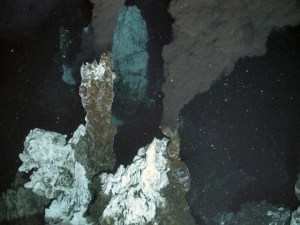
Hydrothermal vent at depth 2.4 km in the Southern Ocean
Deep-sea vents occur in “vent fields”, each of which is a collection of vent chimneys clustered together in a relatively small area. Vent fields vary in size: some are just a couple of hundred metres across, while at others the vent chimneys can be spread over several kilometres.
Vent fields are separated from each other on the seafloor by relatively large distances where there is no vent activity. In some regions, vent fields can be a few kilometres apart from each other, but in other regions it can be several hundred kilometres from one vent field to its nearest neighbour. So overall, vent fields are rather like “islands”, dotted around the ocean floor, and varying in size and spacing.
The activity of each vent field does not last forever. Depending on their geological setting, some vent fields may only be active for a few decades, before their fluid flow shuts down, for example if the area is smothered by lava flows from nearby undersea volcanoes, or if the “plumbing” beneath the vent field is disrupted by earthquake activity. In other regions, however, a vent field can remain active for thousands of years – and go through cycles of activity, switching “on and off” for several millennia at a time.
So this is a key point that we will come back to later: deep-sea vents are not the same the world over. Some are smaller in area than others, and some are naturally active for thousands of years.
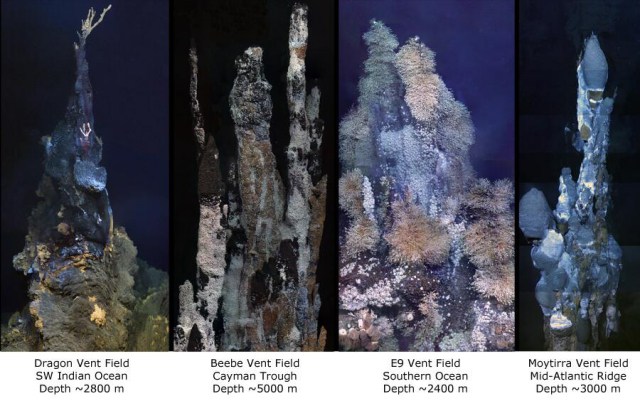
"Chimneys" at newly discovered vent fields around the world
At active vents, microbes thrive by using some of the dissolved minerals in the vent fluids as an energy source, in a process known as “chemosynthesis”. These microbes in turn provide food for species of deep-sea animals, many of which are only found in such “chemosynthetic” islands of life on the ocean floor.
However, those animal species are never unique to an individual vent field, because if they were, they would go extinct when that vent field shuts down naturally. The “vent” animals therefore have larval stages in their life cycles that are adapted to disperse between vent fields, which allows them to avoid extinction despite the temporary nature of their adult colonies.
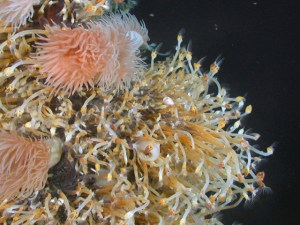
Marine life at a hydrothermal vent 2.4 km deep in the Southern Ocean
Although vent species are not unique to individual vent fields, however, they are specific to particular regions – one species, for example, may be found at vents along 3000 km of mid-ocean ridge, and then either geological or oceanographic barriers may isolate it from other species at vents in neighbouring regions.
So this is another key point that we will come back to later: vent fields are naturally ephemeral, and may be inhabited by species of animals only found at vent fields in a particular region, but never only at one individual vent field.
What is involved in mining at vents?
From plans already made by mining companies, “mineral extraction” will involve machines on the seafloor scraping up and pulverising the “seafloor massive sulfide” (SMS) deposits at a vent field, i.e. the vent chimneys and associated rubble around them.
This material will be pumped to a surface facility, where the metals will be extracted. The remaining matter will be turned into a slurry, and in some cases may be pumped back down into the depths, to disperse from a pipe in mid-water and eventually settle across a wide area of the seafloor at very low concentration, similar to the fall-out from the natural plume of particles dispersing from the vents themselves.
What marine life will be most affected?
Now let’s think about the marine life that is likely to be most affected by mining at deep-sea vents. Mining on land has an impact on local wildlife, but on land that wildlife usually occupies habitats much larger than just the area being mined. So although some garden snails or earthworms may be killed by an excavation on land, that impact doesn’t usually cause concern, because those species are still common in unaffected areas.
So it is important to make a distinction between “normal” deep-sea animals that are found in extensive habitats beyond deep-sea vents, and “vent” animals that are only found in vent environments.
The plume of particle-laden waste water from seafloor mining could have an impact on “normal” deep-sea animals, for example suspension-feeding corals living on rocky seafloor away from the vents, or mid-water animals if the plume clouds the water (remember that many deep-sea animals still use light to communicate, hunt, and evade predators, even at depths beyond on the reach of sunlight).
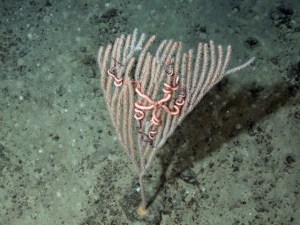
Deep-sea coral and brittlestar
But those kinds of animals usually have very wide distributions away from vents in the deep sea, so in terms of habitat loss or species extinction they are not particularly at risk from mining at vents; the impacts on them are similar to those on the garden snails and earthworms of our land-mining analogy. The same applies to animals that may be affected by noise or other disturbance from mining activity, if their species have wide distributions and large populations beyond the impact area.
How will “vent” animals be affected?
But what about the impacts on the “vent” animals, which only live in vent environments as adults? The animals living on vent chimneys macerated by the mining machines will be killed. But vent fields are naturally ephemeral features: when a vent field shuts down naturally, all the animals living there die out. So mining, it is argued, simulates a natural disturbance process at an individual vent field.
In fact, mining does not “switch off” activity at a vent field; instead, it effectively resets the vent field to “time zero” in its natural development, by scraping the seafloor back to bare basalt with hot fluid still gushing out of it. We know that the larvae of “vent” animals can recolonise that site from other vent fields in the region, because they did so when venting at that site first began (though how variable larval supply is, and whether a community will always follow the same pattern of development, is not yet known for vent fields in many regions). And the chimneys grow back too (for example, we have seen chimneys grow several metres in a year between visits to some sites).
So on the face of it, mining at vents might seem an attractive proposition (and the word “sustainable” has even been used by some to describe it). But as is often the case in the natural world, issues arise when we consider cumulative effects across a region, rather than individual sites.
What are the risks to “vent” animals from mining?
In the Western Pacific, where plans for mining at vents are arguably most advanced, most of the vent fields are associated with “back-arc spreading”, rather than being found on mid-ocean ridges. These “back-arc” vent fields can be extensive, for example stretching over kilometres of seafloor in a ring around the summit of an underwater volcano.
At many of these “back-arc” vent fields, it is possible to mine just one part of the vent field, while creating “set-asides” or “reserves” within the same vent field or area, from which animals can recolonise the mined area afterwards.
That is exactly what mining company Nautilus Minerals proposes to do at the Solwara-1 vent field near Papua New Guinea, and they have worked extensively with scientists in the US to understand patterns of gene flow and thereby define what should be effective reserve areas as sources for recolonisation.
Looking at those plans as an independent observer, I think they will work in terms of mitigating the impact on “vent” animals. The mined area should recover, with chimneys regrowing and “vent” animals recolonising them.
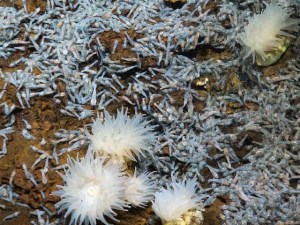
Marine life at Beeve Vent Field, depth ~5 km in the Caribbean
But – and it is a very big “but” – not all the vent fields on mid-ocean ridges are like the “back-arc” vent field of Solwara-1. At mid-ocean ridges, would-be seafloor miners are targeting vent fields on “slower-spreading” ridges, such as the Mid-Atlantic Ridge and SW Indian Ridge. Vent fields on a slower-spreading ridges are often much less extensive in size than “back-arc” vent fields such as Solwara-1, and each vent field on a slower-spreading ridge is typically active for several millennia.
The TAG hydrothermal mound on the Mid-Atlantic Ridge, for example, is one of the largest known mid-ocean ridge sulfide deposits, but its main active mound is only ~200 metres across, unlike the chimneys spread over kilometres at Solwara-1. And the TAG mound has been active for at least 20 000 years, in cycles of activity and inactivity each lasting 4000 to 5000 years, revealed by “geochronology” of its mineral deposits.
So at the smaller vent fields on mid-ocean ridges, it is not feasible to create “set-aside” or “reserve” areas within a vent field that is being mined: it will be “all-or-nothing” for that particular vent field, considering the footprint required for machinery on the seafloor. And most importantly: the natural rate of vent-field-wide disturbance on slower-spreading ridges, to which their marine life may be adapted, seems to be once every few millennia.
On slower-spreading ridges, we don't yet know how rapidly a colony of “vent” animals develops from “time zero” to become identical to the well-established colonies that we have found so far. We have not yet found a single vent field close to “time zero” on a slower-spreading ridge: the ones we have seen so far have large mineral deposits, indicating that they have been active for some time, and their ecology has remained largely unchanged over the decades that scientists have been visiting them, unlike shorter-lived vent fields elsewhere in the world. If early stage vent fields on slower-spreading ridges have a different ecology, then mining of several vent fields in a region could reduce the habitat available for species that only inhabit mature colonies.
So this the main impact of concern for “vent” animals: if mining “resets” vent fields in a region at a much higher rate than they “reset” naturally, then we could see overall habitat loss for some “vent” species particular to that region, and ultimately an increased extinction risk for those species as a result of our activities. What really matters will be the rate at which we disturb these systems by mining, across a region, compared with their natural rate of disturbance at vent-field scale, and the rate of response of animal colonies to such disturbances on slow-spreading mid-ocean ridges, which we don’t yet know at vent-field scale.
What can be done to reduce the risk of habitat loss and species extinction at vents on slow-spreading mid-ocean ridges?
The most obvious answer to that question is “not to mine those vents”. But if mining does go ahead at active vents on slow-spreading mid-ocean ridges, it must be carefully controlled at a regional scale, for example identifying a network of vents in a region that must be conserved to ensure viable “metapopulations” of species to recolonise mined sites. And it will take considerably more research and exploration to inform such an approach in each region.
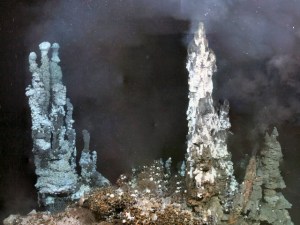
"Ivory Towers" vent chimney, depth 2.4 km, Southern Ocean
There is also an alternative at this point: for every “active” vent field on a slow-spreading mid-ocean ridge, there are probably at least ten inactive vent fields, where venting has ceased naturally but where the vent chimneys have not yet been buried by sediments. As venting has ceased at these sites, the “vent” animals have moved on – but the metal-rich mineral deposits remain. So potentially, it might be possible to mine inactive vent fields on slow-spreading mid-ocean ridges without the impacts on “vent” animals that we have considered here.
(Recent research shows that marine life at inactive vents can still benefit from chemosynthesis at nearby active vents, but the species involved are “normal” deep-sea animals, typically with wide distributions beyond inactive vents, so they may be similar to the earthworms and snails of our land-mining analogy).
Inactive vent fields may be less attractive to would-be miners, however, because they are harder to find. We find active vent fields thanks to the plume of mineral-rich fluids gushing out of them, but inactive vent fields lack those tell-tale signals. But it could still be possible to restrict mining of vents on mid-ocean ridges in international waters to inactive sites.
Jon Copley, March 2014
| Previous | Index | Next |



